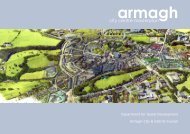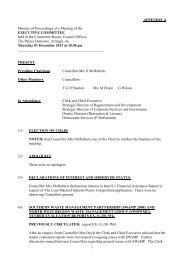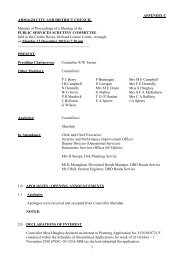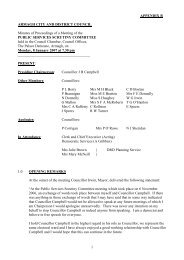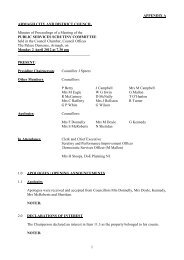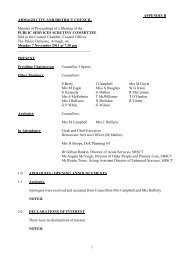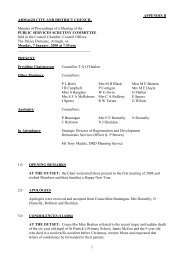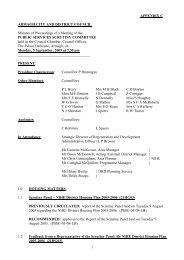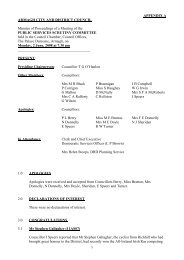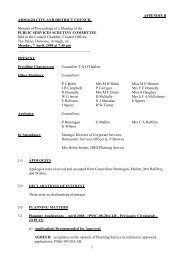Appendices - Armagh City and District Council
Appendices - Armagh City and District Council
Appendices - Armagh City and District Council
You also want an ePaper? Increase the reach of your titles
YUMPU automatically turns print PDFs into web optimized ePapers that Google loves.
STAGE ONE REPORT<br />
The Paul Hogarth Company<br />
Evidence in support of an <strong>Armagh</strong> Masterplan<br />
<br />
<br />
<br />
<br />
Trading: external dem<strong>and</strong> will be lower over the short-term. Northern Irel<strong>and</strong>’s key export<br />
markets the UK <strong>and</strong> Republic of Irel<strong>and</strong> are forecast to slow in the next two years. The<br />
challenge to local businesses is to maintain their level of exports to these markets <strong>and</strong> look<br />
further a field for new opportunities;<br />
Inward Investment: with slowing economic activity <strong>and</strong> concern over the possible effects of<br />
the credit crunch, firms are likely to reduce their inward investment activity. As a result, the<br />
region <strong>and</strong> <strong>Armagh</strong> will likely find that potential new inward investment will be scarce in the<br />
next few years;<br />
Skills: it is forecast that developing economies will continue to out grow developed<br />
economies in the next few years as they take advantage of lower costs, faster growing<br />
populations, <strong>and</strong> rising disposable income. The challenge for Northern Irel<strong>and</strong> <strong>and</strong> <strong>Armagh</strong><br />
is to compete less on costs, <strong>and</strong> more on quality. Local business will need to move into high<br />
value added activity. In order to achieve this, it will have to rely on higher levels of skills <strong>and</strong><br />
available labour; <strong>and</strong><br />
Government spending: In addition, given the planned slow down in Government spending<br />
growth in the UK <strong>and</strong> Northern Irel<strong>and</strong>, the economy can no longer rely on the public sector<br />
to act as a key driver of the economy. The challenge is to grow the private sector, despite<br />
the changing economic environment highlighted above.<br />
2.7 As a result, growth in the local economy is likely to slow over the next few years. However<br />
beyond the slow down, there are likely to be a number of sectoral trends:<br />
<br />
<br />
Agriculture <strong>and</strong> manufacturing: are likely to contract in employment terms. Given lower<br />
real incomes in agriculture in recent years, the sector is likely to experience a period of<br />
change as farms merge to realise economies of scale. In manufacturing, businesses will<br />
need to move away from competing on cost <strong>and</strong> into higher value added activity. Although<br />
this is likely to see a reduction in employment, productivity <strong>and</strong> turnover should rise;<br />
Construction: the construction sector is forecast to grow going forward as the £18bn ISNI is<br />
carried out over the next decade. The scale <strong>and</strong> types of projects will also offer local<br />
companies the chance to build up their expertise <strong>and</strong> export their services;<br />
Finance <strong>and</strong> business services: are likely to grow. These sectors are currently<br />
underdeveloped when compared to the UK or Republic of Irel<strong>and</strong>;<br />
<br />
<br />
Creative industries: industries such as media, IT <strong>and</strong> advertising are likely to grow in<br />
importance as, overall the economy becomes more private services orientated;<br />
Retail: the retail sector has undergone considerable development in recent years, with a<br />
number of high profile developments. Looking forward, this should slow down, as the sector<br />
becomes saturated;<br />
Pharmaceuticals: sectors that rely on high levels of innovation <strong>and</strong> R&D like<br />
pharmaceuticals are likely to grow in importance as highly skilled labour are used to<br />
compete on quality; <strong>and</strong><br />
<br />
Public sector: given the rising population levels, the education <strong>and</strong> health sectors are likely<br />
to continue to grow. However employment in the public administration sector faces a more<br />
uncertain future with the Review of Public Administration (RPA), strive for efficiency savings,<br />
<strong>and</strong> a slow down in public spending.<br />
Population trends<br />
2.8 <strong>Armagh</strong> <strong>District</strong> <strong>Council</strong> has experienced a growing population over the last 15 years.<br />
Analysis shows that over the period 1991 to 2006, the working age population grew faster<br />
than the total population (14.6% compared to 8.6%). Although over the next 15 years this is<br />
likely to change with the total population level forecast to grow more than the working age<br />
population, at 19% <strong>and</strong> 15% respectively.<br />
39



